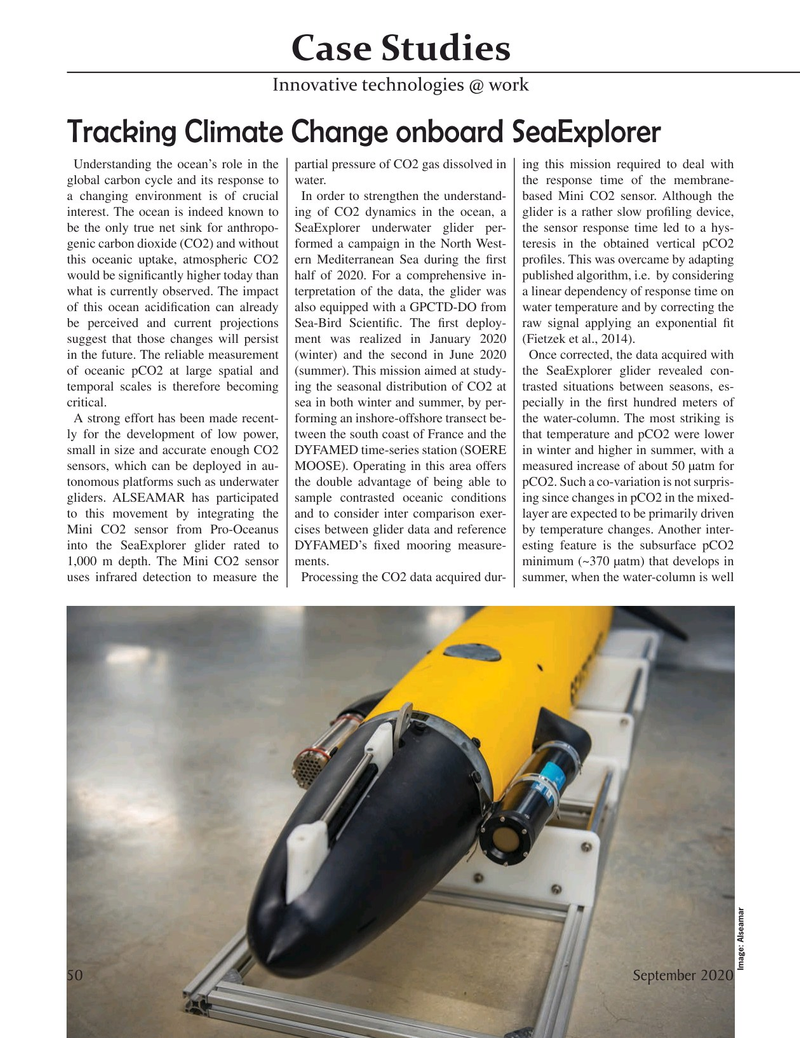
Page 50: of Marine Technology Magazine (September 2020)
Read this page in Pdf, Flash or Html5 edition of September 2020 Marine Technology Magazine
Case Studies
Innovative technologies @ work
Tracking Climate Change onboard SeaExplorer
Understanding the ocean’s role in the partial pressure of CO2 gas dissolved in ing this mission required to deal with global carbon cycle and its response to water. the response time of the membrane- a changing environment is of crucial In order to strengthen the understand- based Mini CO2 sensor. Although the interest. The ocean is indeed known to ing of CO2 dynamics in the ocean, a glider is a rather slow pro? ling device, be the only true net sink for anthropo- SeaExplorer underwater glider per- the sensor response time led to a hys- genic carbon dioxide (CO2) and without formed a campaign in the North West- teresis in the obtained vertical pCO2 this oceanic uptake, atmospheric CO2 ern Mediterranean Sea during the ? rst pro? les. This was overcame by adapting would be signi? cantly higher today than half of 2020. For a comprehensive in- published algorithm, i.e. by considering what is currently observed. The impact terpretation of the data, the glider was a linear dependency of response time on of this ocean acidi? cation can already also equipped with a GPCTD-DO from water temperature and by correcting the be perceived and current projections Sea-Bird Scienti? c. The ? rst deploy- raw signal applying an exponential ? t suggest that those changes will persist ment was realized in January 2020 (Fietzek et al., 2014).
in the future. The reliable measurement (winter) and the second in June 2020 Once corrected, the data acquired with of oceanic pCO2 at large spatial and (summer). This mission aimed at study- the SeaExplorer glider revealed con- temporal scales is therefore becoming ing the seasonal distribution of CO2 at trasted situations between seasons, es- critical. sea in both winter and summer, by per- pecially in the ? rst hundred meters of
A strong effort has been made recent- forming an inshore-offshore transect be- the water-column. The most striking is ly for the development of low power, tween the south coast of France and the that temperature and pCO2 were lower small in size and accurate enough CO2 DYFAMED time-series station (SOERE in winter and higher in summer, with a sensors, which can be deployed in au- MOOSE). Operating in this area offers measured increase of about 50 µatm for tonomous platforms such as underwater the double advantage of being able to pCO2. Such a co-variation is not surpris- gliders. ALSEAMAR has participated sample contrasted oceanic conditions ing since changes in pCO2 in the mixed- to this movement by integrating the and to consider inter comparison exer- layer are expected to be primarily driven
Mini CO2 sensor from Pro-Oceanus cises between glider data and reference by temperature changes. Another inter- into the SeaExplorer glider rated to DYFAMED’s ? xed mooring measure- esting feature is the subsurface pCO2 1,000 m depth. The Mini CO2 sensor ments. minimum (~370 µatm) that develops in uses infrared detection to measure the Processing the CO2 data acquired dur- summer, when the water-column is well
Image: Alseamar 50 September 2020
MTR #7 (50-63).indd 50 9/11/2020 12:59:16 PM

 49
49

 51
51
